
The Department of Mathematics Education

and to overlay several graphs of
for different values of a, b, or c as the other two are held constant.
From these graphs discussion of the patterns for the roots of
can be followed. For example, if we set
for b = -3, -2, -1, 0, 1, 2, 3, and overlay the graphs, the following
picture is obtained.
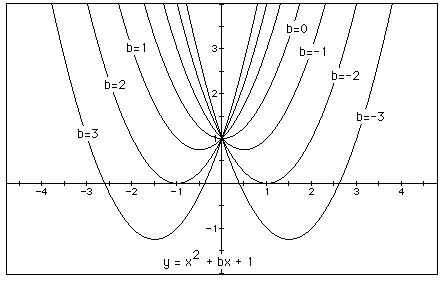
We can discuss the "movement" of a parabola as b is changed.
The parabola always passes through the same point on the y-axis ( the point
(0,1) with this equation). For b < -2 the parabola will intersect the
x-axis in two points with positive x values (i.e. the original equation
will have two real roots, both positive). For b = -2, the parabola is tangent
to the x-axis and so the original equation has one real and positive root
at the point of tangency. For -2 < b < 2, the parabola does not intersect
the x-axis -- the original equation has no real roots. Similarly for b =
2 the parabola is tangent to the x-axis (one real negative root) and for
b > 2, the parabola intersets the x-axis twice to show two negative real
roots for each b.
Now consider the locus of the vertices of the set of parabolas graphed from
Show that the locus of the vertices is the parabola
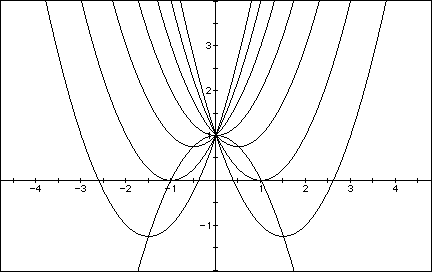
To allow students to generalize have them try several other sets of quadratics.
For example use:


They might use XFunctions 2.2 to graph several more cases to be convinced
that the locus of points of the vertices is the parabola ![]() . Hopefully with
several other examples they would generalize the equation to
. Hopefully with
several other examples they would generalize the equation to ![]() .
.
Consider again the equation
Now graph this relation in the xb plane. To obtain the graph we must
solve for b which yields ![]() . By selected points for x we get the
following graph.
. By selected points for x we get the
following graph.
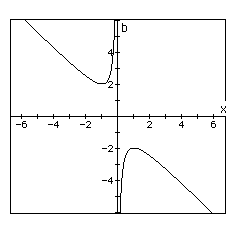
If we take any particular value of b, say b = 3, and overlay this equation
on the graph we add a line parallel to the x-axis. If it intersects the
curve in the xb plane the intersection points correspond to the roots of
the original equation for that value of b. We have the following graph.
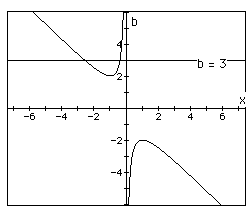
For each value of b we select, we get a horizontal line. On a single
graph we find that we get two negative real roots of the original equation
when b > 2, one negative real root when b = 2, no real roots for -2 <
b < 2, One positive real root when b = -2, and two positive real roots
when b < -2.
This can also be demonstrated by examining the discriminant to determine
if there a 0, 1 or 2 solutions. Note the discriminant yields a positive
value when b > 2, the discrimnant = 0 when b =2, and the discriminant
<0 when -2 < b< 2. Students should be encouraged to draw the horizontal
lines and describe the solutions.
Consider the case when c = - 1 rather than + 1.
In the following example the equation
is considered. If the equation is graphed in the xc plane, we find that
the curve will be a parabola![]() . For each value of c considered, its
graph will be a line crossing the parabola in 0, 1, or 2 points -- the intersections
being at the roots of the orignal equation at that value of c. In the graph,
the graph of c = 1 is shown. The equation
. For each value of c considered, its
graph will be a line crossing the parabola in 0, 1, or 2 points -- the intersections
being at the roots of the orignal equation at that value of c. In the graph,
the graph of c = 1 is shown. The equation
will have two negative roots -- approximately -0.2 and -4.8.
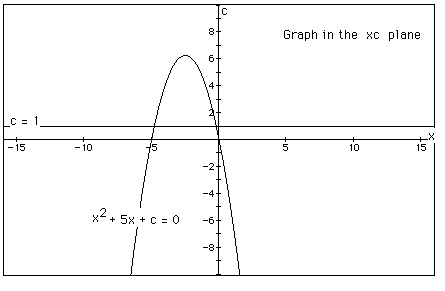
There is one value of c where the equation will have only 1 real root
-- at c = 6.25. For c > 6.25 the equation will have no real roots and
for c < 6.25 the equation will have two roots, both negative for 0 <
c < 6.25, one negative and one 0 when c = 0 and one negative and one
positive when c < 0.